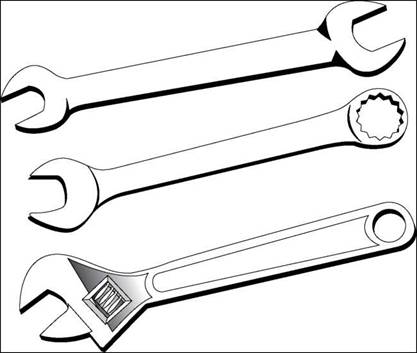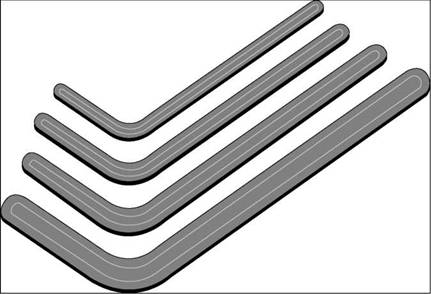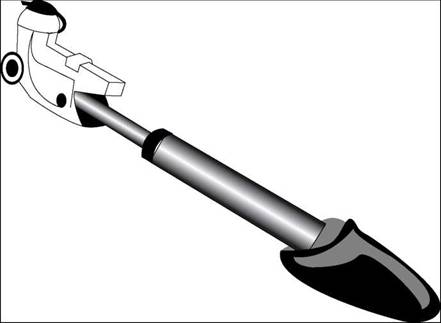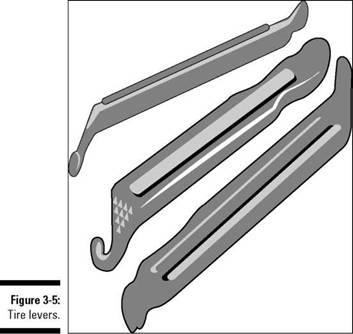Tools of the Trade
If you were tired of eating out every night and decided to learn how to cook, you’d want to make sure your kitchen was stocked with all the necessary cooking supplies. The same applies to bike repair and maintenance. If you’re interested in taking care of your bike, you need some basic tools in order to be successful. If you’re really serious about becoming a gourmet chef of the biking world, and want to handle advanced repairs and maintenance, you’ll need to buy some additional tools. First, we start with the basics.
Assembling your bike-tool starter kit
|
|
If you’re looking for a basic set of tools to allow you to start caring for your bike, everything in this section is what I recommend. (See Figure 3-1 for an illustration.) You probably already have some of these tools in your house; other tools you’ll be able to buy with very little cost and from a variety of sources.
Buying tools in sets will save you money as compared to buying them individually. Buying a tool sets will also give you more options when it comes to working on different parts of your bike.
Wrenches
When working on a bike, you’ll find yourself grabbing wrenches a lot. You have many options when it comes to wrenches, including open-ended, box, and combination (see Figure 3-1).
Many people keep an adjustable crescent wrench (refer to Figure 3-1) around the house because of its flexibility; you can use one on a bike, although you’re better off using non-adjustable wrenches when possible, because they tend to fit more snugly to a nut or bolt. If an adjustable wrench slips while tightening or loosening, it could cause damage to a nut or bolt — not to mention your knuckles.
|
|
When shopping for wrenches look for sizes 7mm to 17mm and every size in between to give you enough coverage for nuts and bolts on a bike.
Wrenches should fit securely over the bolt or nut before turning. If you aren’t sure which wrench to choose, select the wrench that fits the most tightly.
|
|
|
Figure 3-1: Wrenches come in many varieties. |
Screwdrivers
|
|
What would a toolbox be without a trusty screwdriver or two? Both flathead and Phillips screwdrivers are necessary for working on a bike. You should have a range of sizes for the various screw heads found on a bike.
In general, the largest screwdriver that can fit a screw head is preferable. Alien wrenches
Allen wrenches (also called hex keys) are the L-shaped tools used to tighten recessed bolts (see Figure 3-2). You use sizes 4, 5, and 6 the most.
Instead of buying a set of Allen wrenches, consider purchasing a mini folding tool — an indispensable and handy little tool that contains Allen wrenches and sometimes screwdrivers, wrenches, and other tools. It’s perfect for taking with you when you bike.
For Allen wrenches, sizes between 4 and 10 mm are usually sufficient.
An Allen wrench should be fully inserted into the socket before turning.
|
|
|
Figure 3-2: Recessed bolts have to be tightened with an Allen wrench. |
Hammer
Sometimes you need a hammer to tap part of a bike, such as when loosening a seat post or removing the pin that holds a crank. A small hammer or plastic mallet will ensure that you can control the blows while avoiding doing damage to your bike.
Pliers
|
|
Pliers come in handy for pulling cables, although they shouldn’t be used for cutting cables. If you plan to cut your own cables, use a cable cutter designed for this activity.
Never use pliers to loosen or tighten nuts and/or bolts — they’ll damage the edges.
Tire tools
If you ride your bike often enough, eventually you’ll need to work on your tires — whether that means keeping them properly inflated or repairing them when you get a flat. Here are all the tire tools you need:
✓ Pump (see Figure 3-3): If you haven’t already purchased one, you’ll want to buy a bike pump that matches your valves — either Presta or Schrader (see Chapter 6 for more on these types of valves). Some of the better-quality pumps will handle both types of valves.
If you have two or more bikes — with both types of valves — you can find a pump that is reversible, allowing you to switch back and forth between types of valves.
|
|
Smaller pumps designed to fit on a bicycle frame are convenient for taking with you on trips — although, they require more pumping to fill a tire, because they’re designed only for emergency repairs on the road and not for routine maintenance inflations. Having a larger pump at home or even an air compressor will make pumping tires a breeze.
|
|
✓ Pressure gauge (see Figure 3-4): To take the guesswork out of filling your tires with air, you can use a pressure gauge. This will help you inflate tires to the proper pressure as indicated on the sidewalls.
Many higher-quality pumps have a built in gauge. With the gauge on the pump, you won’t have to search for it at the bottom of your toolbox every time. Plus, you don’t have to go back and forth, between pumping and checking pressure.
✓ Patch kit: Sooner or later, you’ll have to patch a leak and unless you want to buy a new tube each time, you’ll want to keep a patch kit available at all times. A patch kid includes
• Patches
• An abrasive to rough up the surface of the tube to improve adhesiveness
• Glue
|
|
|
Figure 3-3: A tire pump is essential to maintaining proper pressure in your tires. |
✓ Tire levers (see Figure 3-5): Tire levers are usually made of stiff plastic and are used to pry a tire off a wheel rim. You’ll probably need three levers, although on some mountain bikes the tires are loose enough that one or two may suffice.
|
|
Lubricants, cleaners, and degreasers
Lubricants, cleaners, and degreasers aren’t technically “tools,” but they’re essential to properly repairing and maintaining your bike. With so many moving parts causing friction, a bike requires proper lubrication — including specially designed oils and greases — to reduce this friction and help prevent rust and corrosion.
The same qualities that give oil and grease their lubricating properties and enable them to stick to external parts are also what attracts dirt and grime. This means that, unlike with your car’s internal parts, you can’t wait 3,000 miles for an oil change. Regular care for your bike requires using cleaners to remove surface dirt and degreasers to cut through heaver grime that’s too strong for normal cleaners.
We cover lubricants, degreasers, and cleaners in the following sections.
Lubricants
If you’re an average rider, an all-purpose lubricating oil designed for bikes will be all that you need. You can use oil to lubricate pivot points such as brakes and derailleurs, as well as to keep the chain lubed.
|
|
Some riders use a lubrication specially designed for a chain. Manufacturers offer a number of quality lubes that are designed with different conditions in mind. A dry wax-based lube is best for dry, summer-like conditions. For the rainy season, a wet lube is the choice for many riders — although a wet lube is messy and attracts dirt and grime, it holds up well to water.
For a great description of use of chain lubes, see Urban Bikers’ Tricks & Tips, by Dave Glowacz (Wordspace Press).
Liquid lubricants can be applied from an aerosol can or a plastic squeeze bottle. We prefer to drip a lubricant out of a bottle because we can control the flow. Spray cans are much more difficult to control and can overlubricate parts.
When you need to loosen a seized part — such as a seat post that won’t budge — use a light, penetrating oil like WD-40.
|
JUG/ |
|
|
WD-40 should not be used as a chain lubricant. Although WD-40 works wonders in getting tight parts moving again, it’s a solvent that will strip away existing lubrication. Although it may appear to be lubricating while it’s wet, as soon as it evaporates, your chain lubrication will be gone. Also keep WD-40 away from shifters, because it may damage the inner parts.
|
|
In addition to oil, grease is needed to support the internal moving parts of your bike, particularly those that depend on bearings to reduce friction. Bearings in the hubs, bottom brackets, headsets, and pedals are packed in grease. When these are overhauled, the grease needs to be replaced. Grease also protects the threads found on the same parts and lubricates and prevents rust from forming on the gear and brake inner wires
Grease is often sold in a tube. Be sure to keep the lid on at all times to prevent contamination.
Buy only grease designed for bikes. Grease for automobile bearings will be too heavy and thick and will gum up your bike.
|
ANG/ |
|
|
Cleaners and degreasers
|
|
The simplest way to clean a bike is to rinse it off with water after a ride. This will dislodge any loose dirt, sand, or grit lodged in the bike’s parts.
When washing your bike, use a light mist spray to avoid directing water into bearing areas, such as hubs or the bottom bracket, where it can break down bearing grease.
|
$ftNG/ |
|
|
A mild soap (such as dish soap) will remove dirt and grime, although it won’t be strong enough to clean grease-laden parts such as the chain rings, cogs, and chains, as well as the insides of hubs, bottom brackets, and the headset.
Although solvents such as gasoline, kerosene, and paint thinner will cut grease and oil, we don’t recommended that you use them because they’re highly flammable, they emit toxic fumes, and they’re very harsh on your bike.
Commercially available degreasers are designed to not harm bike components — or you. Many of them are biodegradable and environmentally friendly. Citrus-based degreasers are among our favorites — they’re made from oil extracted from orange peels. A number of green cleaners are also available — not only will they clean your bike, but they don’t give off the toxic fumes associated with typical solvents.
















